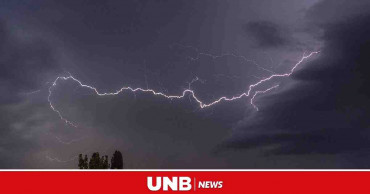deadliest disaster
Lightning strike turning into deadliest disaster in Bangladesh: Experts
Lightning strike has turned into one of the deadliest natural disasters in Bangladesh claiming over 200 lives every year due to the loss of natural defense and lack of precautionary measures, say experts.
They blame deforestation, worsening air pollution and global warming, climate variability, and the growing use of mobile and other technological devices for the increase in the frequency of lightning strikes.
According to the Ministry of Disaster Management and Relief, 2,164 people died in lightning strikes in the country from 2011 to 2020. At least 216 people die every year on average in lightning strikes, more than by floods, cyclones and other natural calamities.
Read: Thunderstorm Lightning Struck Safety Tips: Stay Prepared
The experts said about 70 percent of the total lightning strikes usually occur between April and June, and advise everyone to move with caution during this time.
Farmers the worst victims
Contacted, Md Rashim Molla, Secretary-General of Save the Society and Thunderstorm Awareness Forum said, at least 177 people, including 122 farmers, were killed and 47 others injured, by lightning strikes across the country in between March 31 and June 7 this year as per their recent study.
The casualties were higher in Sunamganj, Netrokona, Kishoreganj and Gaibandha districts over the last one and a half months. “Most of those killed by lightning strikes were working in open fields or fishing. About 90% of the victims were men.”
He said lightning has now turned into the deadliest natural disaster in the country. “The death toll from lightning strikes is much higher than that of cyclones and tidal surges, landslides and floods.”
Rashim said people in rural areas, croplands or playground and open spaces are mainly falling victims to lightning strikes for lack of protection.
Causes behind
Prof Ainun Nishat, a noted climate change researcher, said it seems the frequency of lightning strikes has increased in Bangladesh due to the rise in temperature caused by climate change. “But data relating to lightning strikes are not collected scientifically in our country. We should take steps for collecting solid data and carry out scientific studies in this regard.”
He said the overall temperature in the world is growing gradually and so far around one degree has already increased. “The growing temperature due to climate change is causing more water evaporation from the land and ocean. It’s increasing black clouds with potential lightning storms.”
Read: 3 killed by lightning strike in Magura, Madaripur, Khulna
Rashim Molla said climate change, decrease in tall trees, increase in rain clouds, random set-up of mobile towers and increase in temperature across the globe can be the main factors behind the unusual rise in thunderstorms.
Besides, Rashim said, a one-degree rise in temperature can cause the chances of thunderstorms to rise by 10 percent.
Gawher Nayeem Wahra, Member Secretary of Disaster Forum, said the main reason behind the increase in lightning strikes is the lack of trees. “Thunderbolts attack the tallest humans in a field or open space without trees.”
“People's knowledge on earthing is low. Old houses that had earthing are gone now along with trees,” he observed.
Gawher said many people die on the spot after being hit by lightning strikes while many injured slowly die as there is no treatment for lightning burns.
What’s the solution?
Ainun Nishat said the hotspots for the lightning strikes should be identified properly through scientific studies and effective steps need to be taken to protect people there. “People should be made aware that they shouldn’t be there in the open field when back clouds gather in the sky.”
He said the government has taken a step for planting palm trees to lessen the casualties, but it takes around 20 years to raise such a tree.
Read: Plant more trees for greener future: Hasina
Besides, the expert said, the Disaster Management Bureau has taken a step to install poles or lightning arresters in the fields across the country. “It’s a good initiative.”
4 years ago

